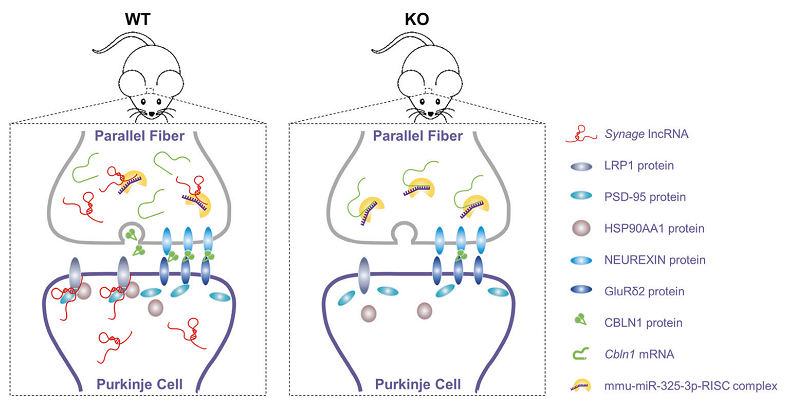Custom-Made AAV was used for gene over-expression. (From
BrainVTA)
The viruses used in this article from BrainVTA are in the table below
|
Custom-Made AAV |
AAV-EF1α-Synage |
|
Control |
AAV-EGFP-control |
Fei Wang, Qianqian Wang, Baowei Liu, Lisheng Mei, Sisi Ma, Shujuan Wang, Ruoyu Wang, Yan Zhang, Chaoshi Niu, Zhiqi Xiong, Yong Zheng, Zhi Zhang, Juan Shi, Xiaoyuan Song
Pub Date: 2021-03-24,
DOI: 10.1038/s41418-021-00774-3,
Email: sales@brainvta.com
The brain is known to express many long noncoding RNAs (lncRNAs); however, whether and how these lncRNAs function in modulating synaptic stability remains unclear. Here, we report a cerebellum highly expressed lncRNA, Synage, regulating synaptic stability via at least two mechanisms. One is through the function of Synage as a sponge for the microRNA miR-325-3p, to regulate expression of the known cerebellar synapse organizer Cbln1. The other function is to serve as a scaffold for organizing the assembly of the LRP1-HSP90AA1-PSD-95 complex in PF-PC synapses. Although somewhat divergent in its mature mRNA sequence, the locus encoding Synage is positioned adjacent to the Cbln1 loci in mouse, rhesus macaque, and human, and Synage is highly expressed in the cerebella of all three species. Synage deletion causes a full-spectrum cerebellar ablation phenotype that proceeds from cerebellar atrophy, through neuron loss, on to synapse density reduction, synaptic vesicle loss, and finally to a reduction in synaptic activity during cerebellar development; these deficits are accompanied by motor dysfunction in adult mice, which can be rescued by AAV-mediated Synage overexpression from birth. Thus, our study demonstrates roles for the lncRNA Synage in regulating synaptic stability and function during cerebellar development.
 Figure 1. A schematic diagram of the mechanism of the Synage lncRNA in the regulation of synaptic and neuronal function in the WT and Synage KO mouse cerebella
Figure 1. A schematic diagram of the mechanism of the Synage lncRNA in the regulation of synaptic and neuronal function in the WT and Synage KO mouse cerebella
In this study, the authors studied this synapse-functional cerebellum lncRNA, particularly three isoforms of Gm2694, which they designated as Synage, and which is distributed in the cytoplasm and synapses of cerebellar cells. They showed that Synage modulates the expression of the synaptic protein CBLN1 in GCs and contributes to preventing cerebellar atrophy and motor defects. They also found that Synage mediates the assembly of the LRP1-HSP90AA1-PSD-95- Synage complex in PCs to regulate synaptic stability. The study presents long-term in vivo data demonstrating the developmental functions of Synage lncRNA and reveals the mechanisms underlying its regulation of synaptic stability and cerebellar development.
BrainVTA offers viral vector construction & virus packaging services for AAV, LV, RABV, PRV, HSV and VSV that help researchers explore questions about genes, neurons, circuitry structure, function of brain network, mechanism and treatment of diseases.
If you have any needs, just email us at
sales@brainvta.com.
